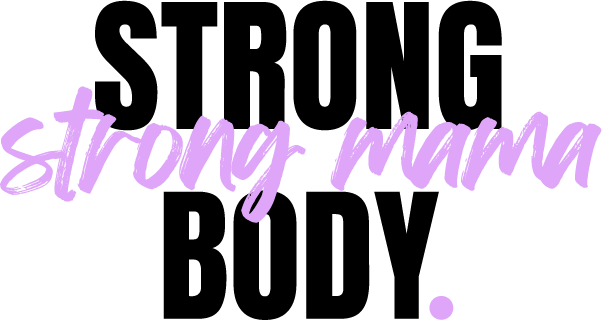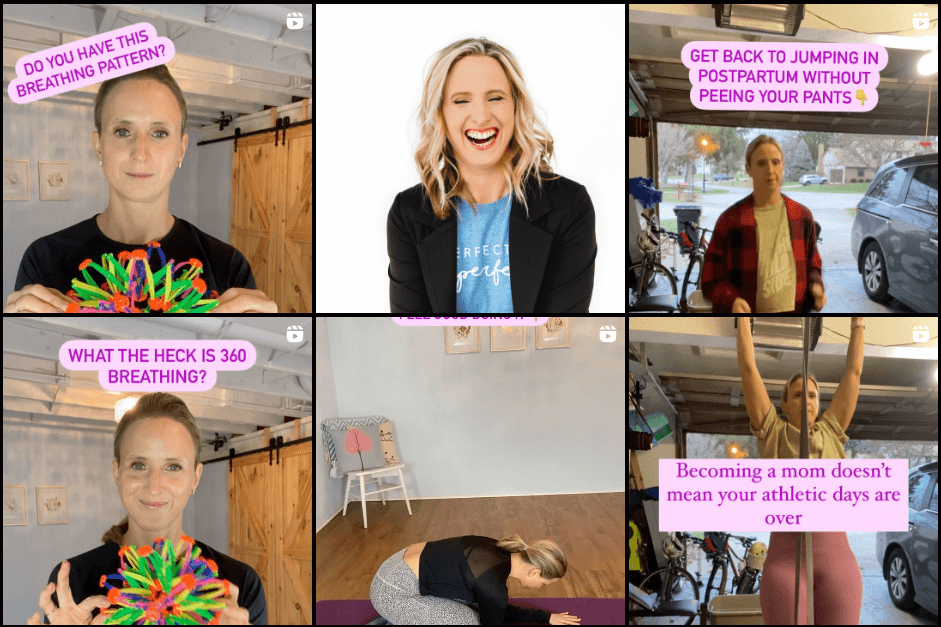New motherhood can be very demanding on a body that has just gone through 9 months of pregnancy and the event of birth.
New mothers spend hours and hours feeding, holding, rocking, and taking care of a new little human…all while recovering from pregnancy and birth.
With all that new work often comes the hunched shoulders, the low back pain, the leaking, and the pelvic floor heaviness symptoms…like hello mom posture syndrome!
Postpartum mom posture is real, but the good news is that you can improve it with the right exercises. Intentional strength training can make a huge difference in your body alignment.
Once you improve your postpartum posture, you’ll feel and move better, and your core and pelvic floor will be able to function better!
Bye bye mom butt, leaking, or heaviness!
The Key To Improving Mom Posture: Stacked Body Alignment
If you want to get back to exercise after birth without leaking and with a strong core, you need to learn how to manage the pressure inside your abdomen (called intra-abdominal pressure).
Did you know your deep core system is a pressure system? You can think of it as a canister (or a can of pop!) with a top (breathing diaphragm), bottom (pelvic floor), front (deep abdominals), and back (back muscles).
When your body is stacked, your rib cage lays right over your pelvis (your diaphragm is over your pelvic floor muscles), and it becomes much easier to manage the pressure inside your abdomen and therefore support your body.

A stacked body position allows your rib cage to sit directly on top of your pelvis.
As a result of a stacked body position, your breathing diaphragm and your pelvic floor can function better together and as teammates. When you take a breath in, your diaphragm lowers and allows for your gut content to push your pelvic floor down and let it relax. When you breathe out, your pelvic floor acts as a piston and recoils up as your diaphragm goes back up.
Common Postural Changes
There are some postural changes that happen during and after pregnancy that warrant some attention and rehabbing.
During pregnancy, your ribs flare upwards to make room for your growing baby.
Also, as your belly grows over the months, your center of gravity shifts forward, and your pelvis gets pulled into a more forward pelvis which can compress your low back. (anterior pelvic tilt).
There is no perfect posture during pregnancy and postpartum, but problems can arise when we get “stuck” in one posture and have difficulty getting out of it or accessing a different posture.

Picture Left: Scissor Posture Presentation Picture Right: Swayback Posture Presentation
3 Mom Posture Symptoms
The extended posture described above is often called a “scissor posture” postpartum. This open scissor posture makes it harder to manage intra-abdominal pressure and limits your movements by reducing the range of motion available to you. Here are 3 mom posture symptoms you might be experiencing.
1) Worsening of diastasis recti
The scissor posture postpartum can put extra pressure on the tissue at the midline of your abdomen called the Linea alba. This connective tissue connects the 2 sides of your rectus abdominus muscles (6 pack muscles). Putting constant extra pressure on this already weakened tissue from 9 months of pregnancy can lead to a worsening of diastasis recti. Also, a scissor posture pushes pressure forward onto your abdomen and down onto your pelvic floor.
2) Increase leaking or heaviness in the pelvic floor
When your ribs aren’t stacked over your pelvis like in a scissor posture postpartum, it is much harder for your pelvic floor to recoil up and support your organs with each breath out. Consequently, the dynamic between your diaphragm and your pelvic floor is negatively impacted and can result in leaking, heaviness in your pelvic floor, or other pelvic floor symptoms.
3) Low back discomfort or SI joint pain
A scissor posture postpartum can chronically put extra pressure on your low back and result in low back pain/discomfort. Think about it as compressing your low back area 24/7 and creating stiffness or tightness in your low back. With your pelvis being pulled forward into an anterior pelvic tilt, your ribs flaring, and your spine constantly extending, you are reducing your range of motion available at your pelvis and low back area.
How To Improve Postpartum Posture
The best way to fix your posture after pregnancy is by practicing a stacked body position.
Here are 2 exercises you can practice to get a sense of what it feels like to have a “stacked body”. You can practice these exercises daily for the next week! Shoot for 10 breaths of each exercise and repeat for 2-3 sets.
1) Hooklying Pelvic Tilt Stacked Body
The #1 mistake I see with my clients trying to find a stacked position is rounding their lower back and clenching the heck out of their lower glutes and posterior pelvic floor instead of using their hamstrings to pull the pelvis posteriorly.
This hooklying exercise helps by activating the proximal hamstrings (hamstrings closest to the pelvis) and using that contraction as a lever to tilt the pelvis posteriorly.
Once you find your stacked body position, inahle silently through your nose and exhale fully out of your mouth pretending to fog a bug mirror.
2) Heels Elevated Isometric Squat With Reach
The isometric heel evevated squat (more upright squat position) is an excellent exercise to practice and feel the stacked body position in your body. I recommend watching yourself in a mirro to help!
A few helpful tips:
1) Keep your knees soft at the top
2) Exhale fully before starting the exercise to bring your rib cage back in space (without dumping your chest down!)
3) Tuck your pelvis slightly but don’t clench your booty!
4) Only go as far down as you can without losing your stacked body position (no back arching and no rounding).
Summary Takeaway
Remember this:
1) When you can find a better stacked body position (ribs over pelvis), you can move more effectively through flexion, extension, external and internal rotation and therefore have better range of motion and movement mechanics.
2) A stacked body position (ribs over pelvis) allows for your diaphragm, pelvic floor, and abdominal muscles to work together more effectively and reduce core and pelvic floor symptoms like leaking, heaviness, or pain.
If you would like a personalized assessment of your posture with tips and exercises tailored to your goals and needs, I offer an Online 80-min Consultation + Assessment Session or check out my 1:1 Online Programming + Coaching services here.



